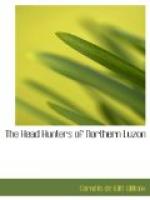On this occasion, the carabao was tied to a stake in a small swale and I nerved myself to look on. I saw the first cuts, the poor beast look up from his grass in astonishment, totter, reel, and fall as blows rained on him from all sides. The crowd, closing in, mercifully hid the rest from view; the victim dying game without a sound. In this respect, as well as in many others, the carabao is a very different animal from the pig. But, while looking on at the mound of cutting, hacking, sweating, and struggling butchers, the smell of fresh blood over all, something occurred that completely shifted the center of interest. A boy came up to us in great excitement to say that the prisoner had got hold of a bayonet and was running amok. This was the prisoner of the morning who had been so badly beaten; to make him more comfortable, he had been laid on the veranda of the cuartel (just behind us), hobbled, but otherwise free. The boy spoke the truth; the prisoner had snatched his bayonet from a passing Constabulary private, and, turning into the cuartel, made for the provincial treasurer, who was busy inside. Him he chased out, getting over the ground with extraordinary rapidity, considering his wounds and hobbles; when we turned to look, the prisoner had come out and was running for just anybody. There was now but one thing to do, and done it was. Some one in authority called out to the sentry on duty before the cuartel. “Kill him!” The sentry, who up to this time had been walking up and down as a sentry should, brought down his carbine, aimed at the running man, and dropped him in his tracks by a bullet through the heart. He then ejected his empty cartridge-case, shouldered his piece, and continued to walk his post as unconcernedly as though he had shot a mad dog; as




